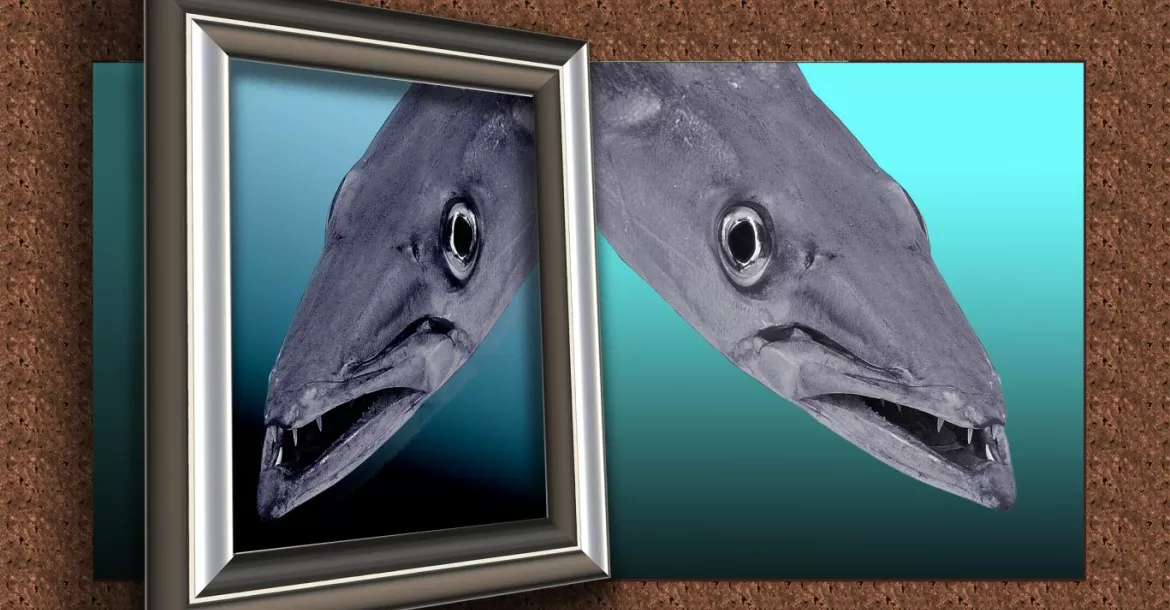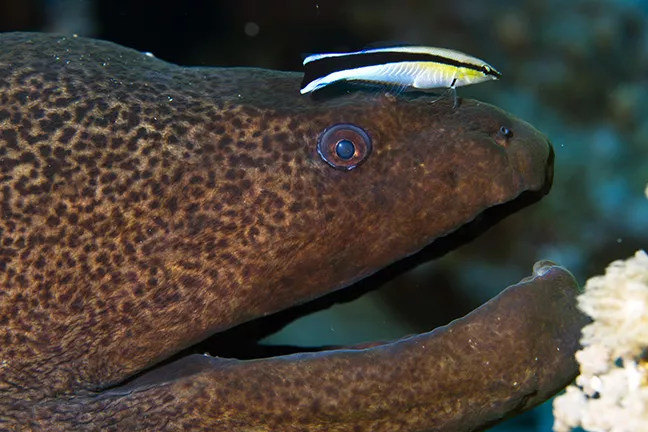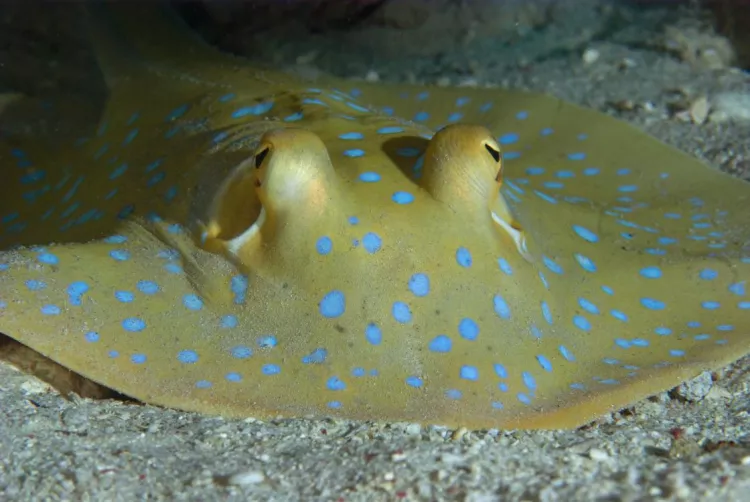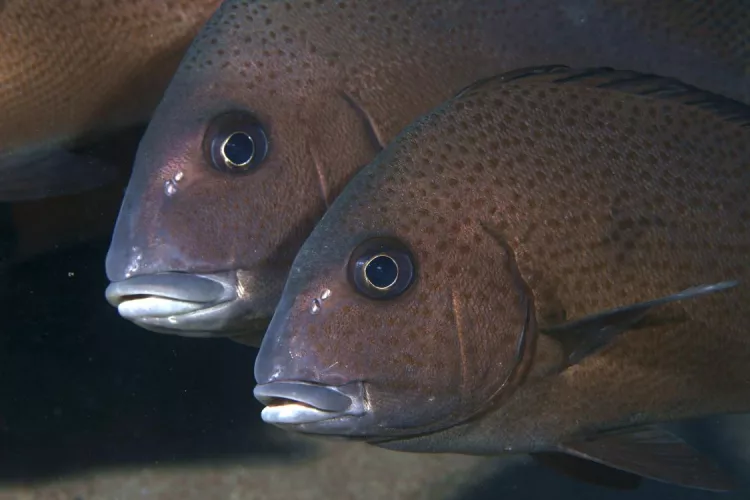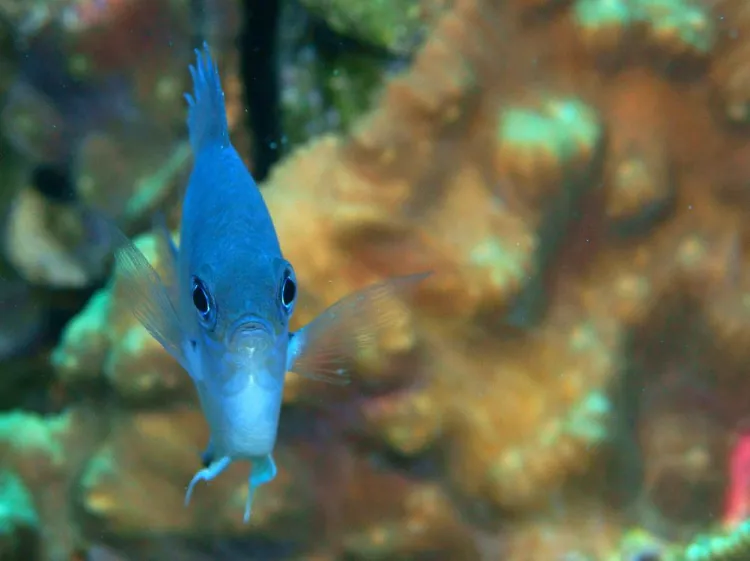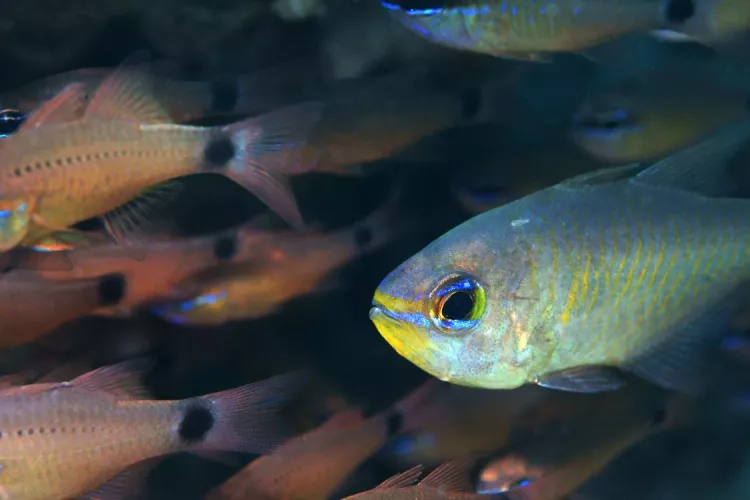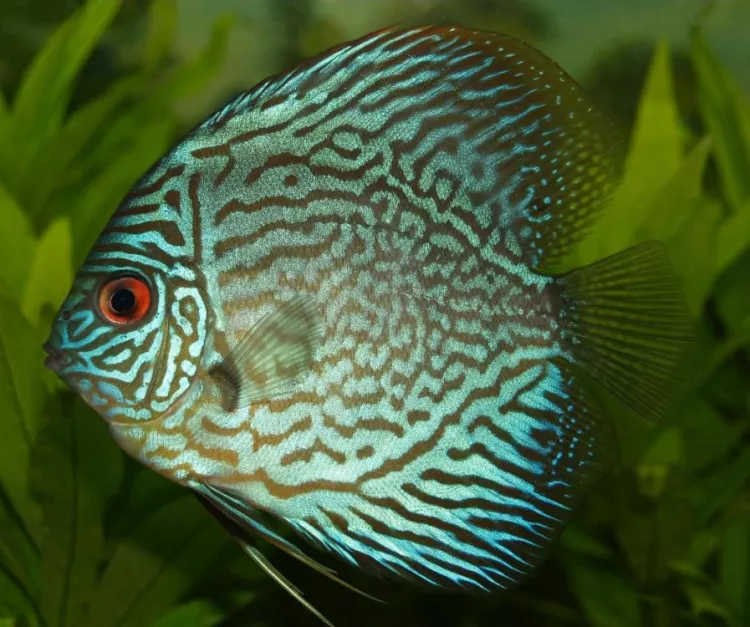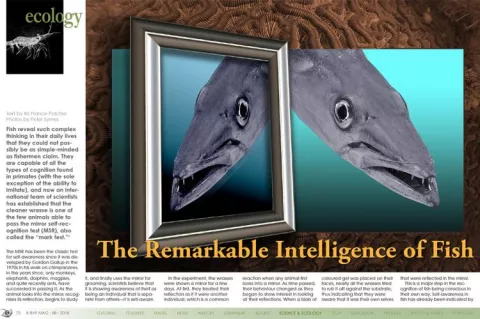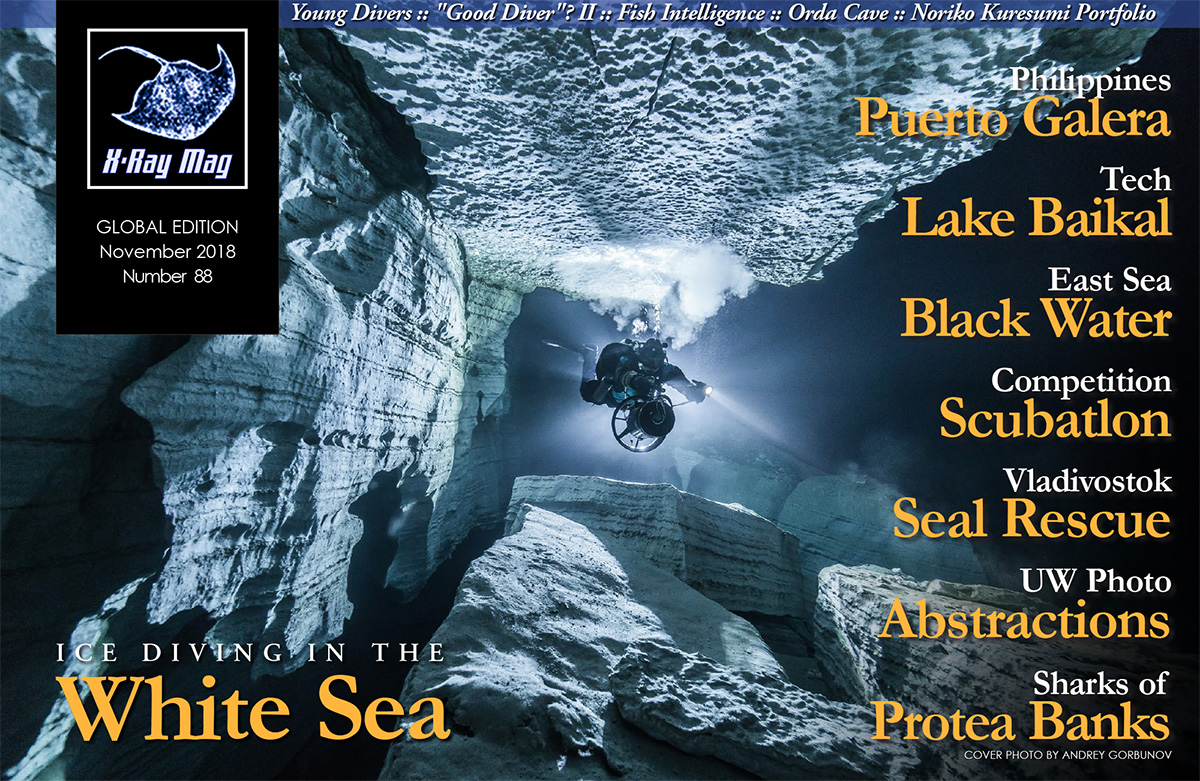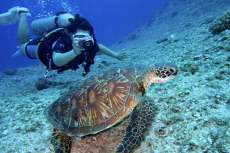Fish reveal such complex thinking in their daily lives that they could not possibly be as simple-minded as fishermen claim. They are capable of all the types of cognition found in primates (with the sole exception of the ability to imitate), and now an international team of scientists has established that the cleaner wrasse is one of the few animals able to pass the mirror self-recognition test (MSR), also called the “mark test.”1
Contributed by
Factfile
Ila France Porcher, author of The Shark Sessions and The True Nature of Sharks, is an ethologist who focused on the study of reef sharks after she moved to Tahiti in 1995.
Her observations, which are the first of their kind, have yielded valuable details about their lives, including their reproductive cycle, social biology, population structure, daily behaviour patterns, roaming tendencies and cognitive abilities.
REFERENCES:
1 Kohda, M, et al. Cleaner wrasse pass the mark test. What are the implications for consciousness and self-awareness testing in animals? PLoS Biology. https://www.biorxiv.org/content/biorxiv/early/2018/08/21/397067.full.pdf
The MSR has been the classic test for self-awareness since it was developed by Gordon Gallup in the 1970s in his work on chimpanzees. In the years since, only monkeys, elephants, dolphins, magpies, and quite recently ants, have succeeded in passing it. As the animal looks into the mirror, recognises its reflection, begins to study it, and finally uses the mirror for grooming, scientists believe that it is showing awareness of itself as being an individual that is separate from others—it is self-aware.
In the experiment, the wrasses were shown a mirror for a few days. At first, they treated their reflection as if it were another individual, which is a common reaction when any animal first looks into a mirror. As time passed, their behaviour changed as they began to show interest in looking at their reflections. When a blob of coloured gel was placed on their faces, nearly all the wrasses tried to rub it off against the substrate, thus indicating that they were aware that it was their own selves that were reflected in the mirror.
This is a major step in the recognition of fish being conscious in their own way. Self-awareness in fish has already been indicated by other facets of their behaviour. The cichlid recognises its own odour as being different and preferable to the odour of other cichlids, including other family members, indicating self-awareness in terms of chemical information.
The tendency to hide at the approach of danger is also considered an indication that the animal is aware of being present and observable, and therefore self-aware. Many fish react to the approach of a diver by hiding. They will also vocalise when threatened.
Inter-species cooperation
Cooperation between species is rare in mammals but seen in fish in a variety of ways. The actions of cleaner fish present one of the most interesting examples. Recognition of others as individuals has long been established in many varieties of fish, both visually and acoustically, and it forms the first step towards the complex social lives in which cognition is most evident.
However, the abilities of cleaner fish go far beyond the simple recognition of other individuals. They demonstrate remarkable social skills in the way they interact with their clients. Full-time cleaners may have as many as 2,300 interactions per day with clients belonging to 100 different species.
Cleaners remove the dead skin and ectoparasites from their clients in return for a meal. They come from many different fish families and depend on cleaning for their diet to varying degrees.
They have their clients categorised as those who only come to their local cleaner, and those whose home ranges include the territories of other cleaners. For the latter, they have competition, so they give them priority over those clients who have no choice of cleaner.
Cleaners sometimes “cheat” by feeding off the client’s healthy flesh as well as doing the usual cleaning job. The clients with no choice of cleaner will punish it by aggressively chasing it, and even inflicting a bite or two. But these clients have been seen to benefit in the future, because the cleaner fish would give them, but not others who visited in the meantime, a better-than-average cleaning service on the next visit.
At times, cleaners will hover above the client and touch it with their fins in an effort to influence its decision to come for a cleaning. This touching tactic is also used to try to reconcile with a client whom they have cheated as described above. Cleaners even exploit the presence of a third party in an attempt to make aggressive clients stop chasing them by going to a nearby predator and caressing it, so that the client dares not continue the chase.
Cleaners will behave altruistically toward their clients if they are being watched by potential new clients—but only those who could visit another cleaning station. Since clients will emulate the behaviour of the former client, the sight of it being treated very well by the cleaner is more likely to convince the potential client to come for servicing than seeing it being chased. This tactic suggests a short-term image, or social prestige, that determines the fish’s success in attracting new clients.
Such complex social behaviour, including cheating, reconciliation, altruism, species recognition, individual recognition, punishment, social prestige and bookkeeping, which is displayed by full-time cleaners 50 to 100 times per day, is considered to indicate consciousness when found in primates.
Another illustration of inter-species social judgment in fish is predator inspection, seen at times when a school of fish is confronted by a possible predator. Different individuals will take turns leading a partner, or a small group of other fish, away from the school to take a closer look at it. Fish who do not take their turn cooperatively, to take the lead in the dangerous situation, will not be trusted by the others in the future. In other words, the fishes make an evaluation of the behaviour of another individual, remember it, and take it into account in future decisions.
A similar example is given by Siamese fighting fish, which have been seen to assess their place in the social hierarchy by watching other fish competing. Also, female guppies will switch mates based on their assessment of competition between other males.
Cooperative hunting
Cooperative hunting was thought to be unique to humans until it was also seen in dolphins. Redouan Bshary described seeing cooperative hunting between Red Sea coral groupers and lunartail groupers, and Javanese moray eels.
A grouper would approach one of the huge eels where it rested in its coral grotto. Then, the fish would shake its body in an exaggerated way in front of it and often, in response, the eel would leave its retreat. Then, fish and eel would go looking for prey, at times swimming so close together that they touched along their sides. The eel would insinuate itself through the cavities and tunnels of the coral structures while the grouper waited for escaping fish.
Tool use
With the exception of humans, fish are more skilful than primates at nest building. At least 9,000 fish species build some sort of nest, either for egg laying or for protection.
The male minnow Exoglossum selects more than 300 stones, all of the same size, from over five metres away, to build a spawning mound 35cm wide and 10cm high. Another fish builds dome-shaped nests from 10,000 pebbles.
The yellowhead jawfish, Opistognathus aurifrons, collects stones of various sizes to build a wall, leaving a hole just big enough to pass through. This involves repeated rearrangement of the stones. In between, the fish searches for new stones that might better fit the available space than the ones it has already collected, using flexible behaviour depending on the circumstances.
Another example showing surprising flexibility of behaviour is the ability of the male tenspine stickleback Pygosteus pungitius, to build his nest around the eggs already laid by the female, though he usually builds the nest first. Great care is required, and a different technique has to be used to avoid damaging the eggs. Since those eggs do hatch, the males achieve their goal in protecting the eggs.
Some species of wrasse have been seen using rocks to crush sea urchins to get at the meat inside.
The eating of sea urchins
The delicacy with which fish approach the problem of eating sea urchins is another way they show their sensitivity to pain, as well as inventiveness.
A bird specialist, Dr Ross Perry, in Australia, sent in the following story:
- “I have befriended a wild Eastern Blue Groper, Achoerodus viridis, that has a passion for sea urchins, the big ones with long sharp dark purplish red spines. She is very selective in how she approaches the sea urchin before striking it repeatedly to crack it open and suck out the contents. Gropers have big fleshy lips and tiny teeth. She prefers me to uncover the underside of the urchin and to hold as many spines back out of the way as practical before striking. Even so a large spine broke off in her lip that fortunately left enough sticking out for me to cuddle her on her return, so I could grasp the spine with finger and thumb and pull it out. This has transformed my thinking about fish as sentient beings.”
Triggerfish, Balistidae, also often feed on sea urchins. Usually, they try to “blow” them onto their side to get access to the unprotected body parts underneath. Hans Fricke observed at Eilat, Israel, how five different individual triggerfish successfully hunted sea urchins by first biting off the spines, which allowed them to grab the urchin and take it to the surface. Then, they fed on the unprotected parts underneath while the urchin slowly sank. In spite of decades of observations, Fricke never saw this behaviour anywhere else and concluded that it was the result of social learning.
Social learning
Social learning involves individual animals learning from each other, as in the example of triggerfish finding a new way to eat sea urchins and copying each other, as described above. In this way, culture can develop in isolated groups.
Migrations are also passed on through social learning. For example, the surgeonfish, Acanthurus nigrofuscus, spawns each year at the same time. Night after night, the small black fish leave their territories all over the lagoon and travel in single file through the coral to their traditional spawning grounds on the lagoon’s border.
They use the same paths each night at precisely the same time, half an hour before sunset, to go to the only place along the border where the outflowing current is exactly balanced by the incoming surge. As a result, the huge cloud of spawn that they left in the gathering night stays in place, held there by the opposing forces of the sea. Each new generation of fish learns the details of the nightly migration from its elders.
Cognitive maps
Intertidal gobies, Gobius soporator, live in tide pools, and during low tide, they can jump from one to another, without being able to see their target pool at the beginning of the jump. Experimentation has shown that the fish memorised the lay of the land around the home pool by swimming over it when the tide was in. So, when the outgoing tide left them only a labyrinth of pools, they had to refer to a three-dimensional memory to navigate. Further experimentation showed that when the fish were displaced, they rapidly returned home, which indicated superior skills involving navigation and orientation.
The fish brain
Though they do have a much simpler neural system than humans, all teleost fishes have elaborate forebrains and the degree of forebrain development has been correlated with social behaviour and communication abilities, which are known to be integrated with cognition. Triggerfish, for example, have a relatively larger telencephalon—the front part of the forebrain—than most other families of fish, due to their advanced foraging techniques.
Fish continue to develop neurons throughout their lives and do so at a faster rate when confronted with a stimulating environment, indicating a link between experience and neural development.
From fish to man, the brain has the same structures, arranged in the same way, with the exception only of the neocortex, which developed in mammals. Neurological studies have shown that the newly evolved neocortex of mammals took over certain higher functions, which were already present in fish, amphibians, reptiles and birds.
It is well established that birds feel pain and have advanced cognitive abilities. Some species have better long-term memories than humans, and others far exceed us in visual recognition. Yet, like fish, their little pea-brains lack a neocortex. The miniaturisation of the animal does not affect mental capability.
Birds provide proof that higher mental capabilities can be found in a brain that is wired differently than ours. Dolphins, too, show high cognitive capabilities, but their brains have a different form than primate brains, though both are mammals. There are people in which the expanded neocortex failed to develop, but who have normal psychology and IQs. So even in humans, it appears that the neocortex is not necessary for consciousness.
Zoologist Donald R. Griffin theorised that the expanded human neocortex is the result of the evolution of our powerful subconscious mind, rather than qualities, such as consciousness, that are unique to humans only. There is overwhelming evidence that all species evolved together, making it impossible for any new quality to appear in only one of them. And no brain is simple, as anyone who has observed the activities of a spider will appreciate.
Fishermen’s arguments
In spite of such evidence, fishermen will continue to argue against the sentience of fish, citing such things as the way a fish will bite a baited hook a second time, after being unhooked and thrown back into the sea. But, while it may be obvious to the fisherman what he is doing, how could it be obvious to the fish? These men assume that the fish understands much more than it possibly could about its situation. It could have no basis among its experiences in life for understanding the fisherman’s practice of deception and the possibility that there is a hook hidden in the bit of food it has found.
It can see no dangerous predator underwater, so how could it imagine that above the surface a man is waiting, hoping to trick and kill it? Even a human in such a situation, walking by the sea pursuing his own affairs, would never suspect that there could be a creature waiting for him beneath the surface with a plan to trap and kill him. A fish that has already bitten a bit of food with a hook in it, has no reason to assume that the next piece of food it finds will also hide a hook.
Consciousness
Consciousness remains a mystery. Though the sensory systems of fish vary depending on species and habitat, in general, they are as good a, or superior to, ours. Mental abilities have evolved in concert with the senses, and fish present a rich fabric of life that networks throughout the waters of the world, its individuals behaving rationally, each in its own habitat and circumstances, each in the pursuit of its life.
There is no basis for denying sentience to them. With the source and nature of consciousness unknown to science, no scientific reason exists for denying it to these fascinating marine animals. ■

